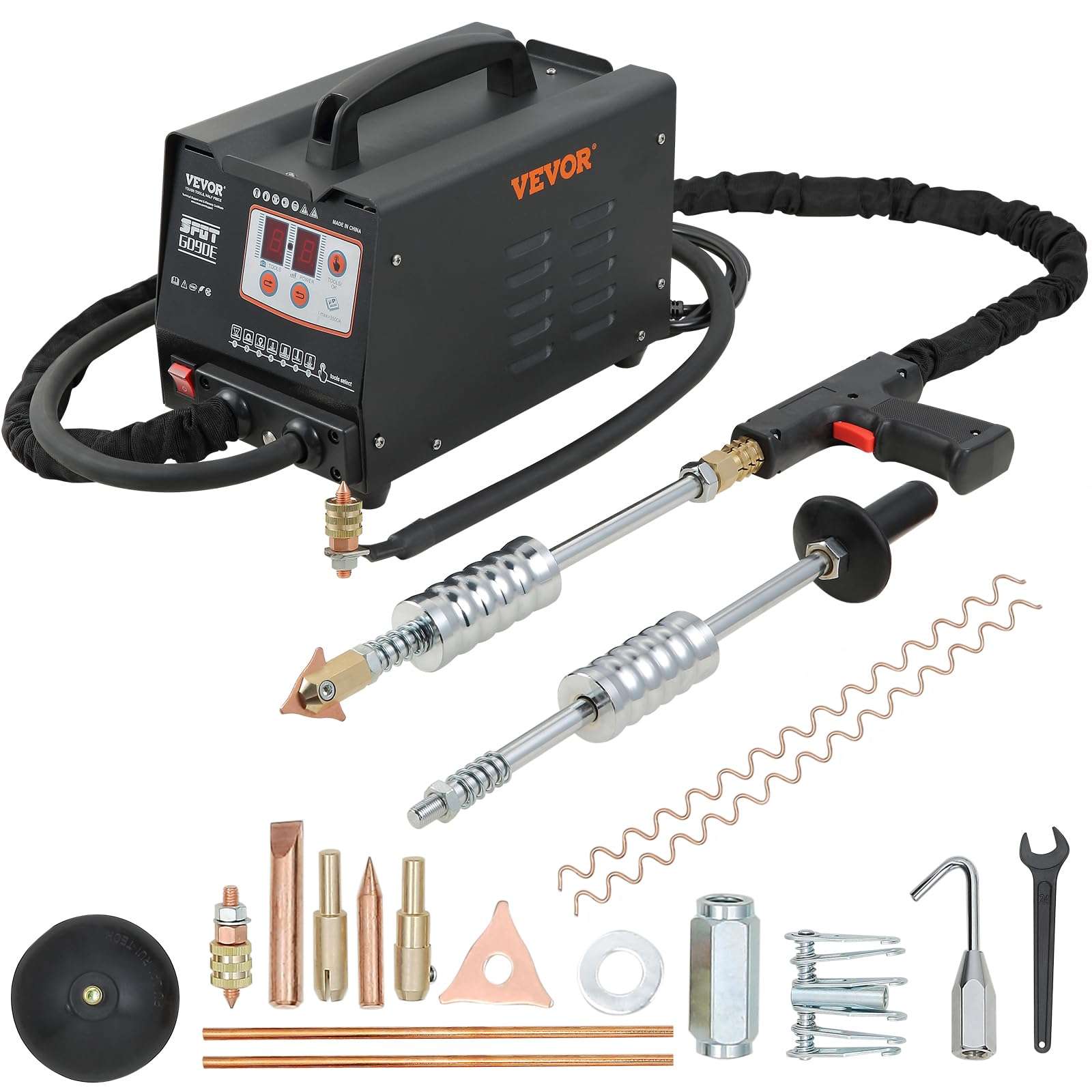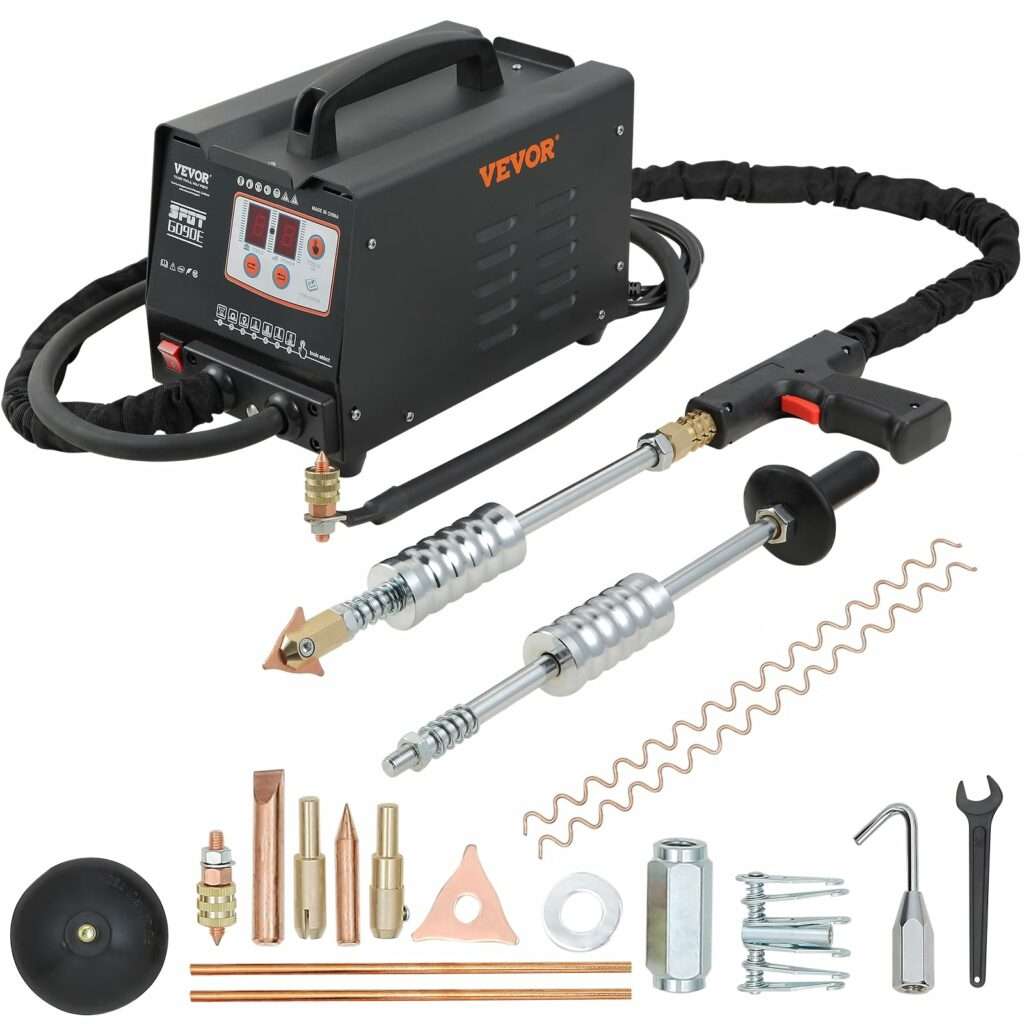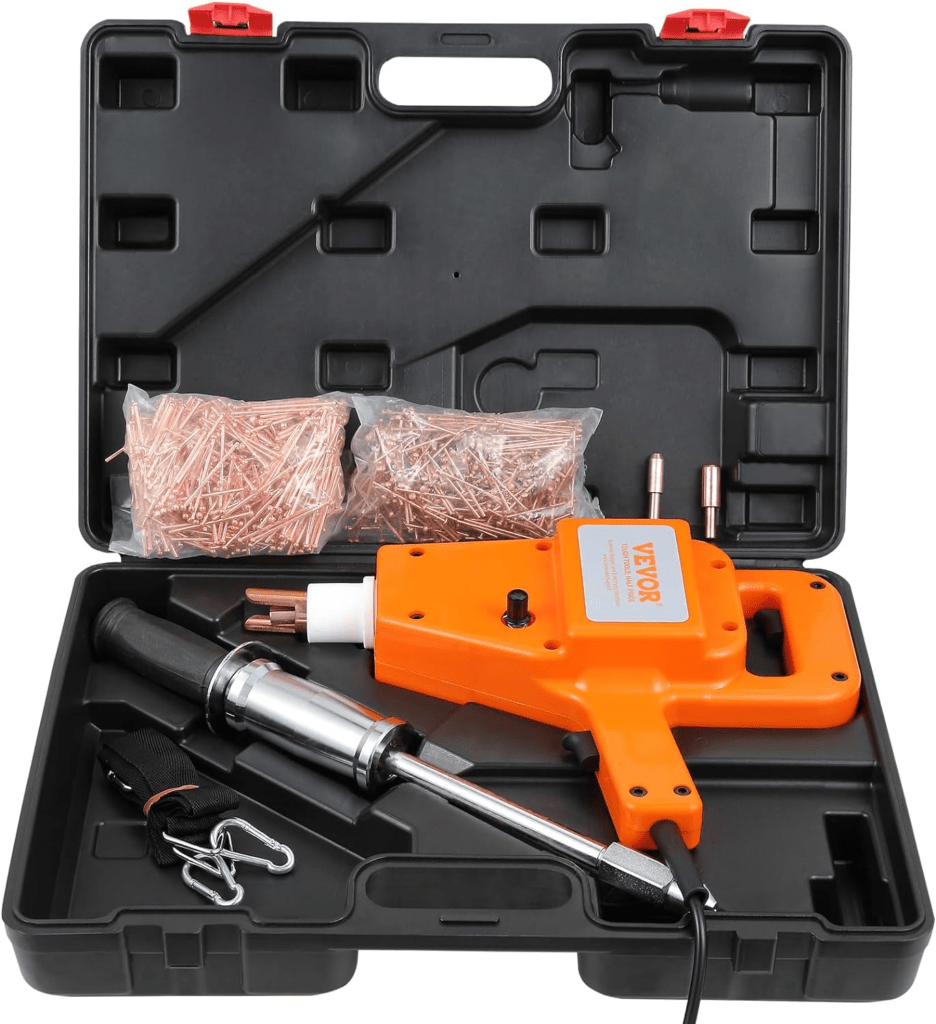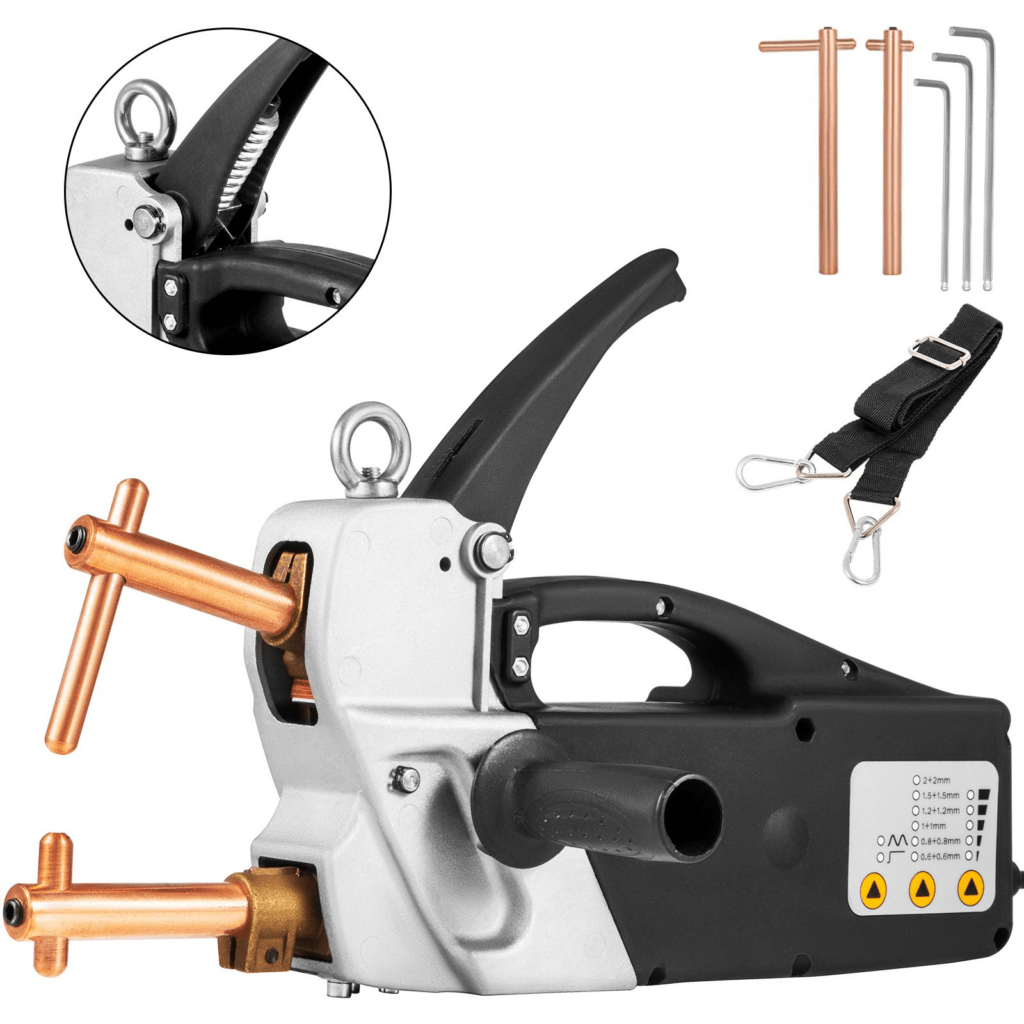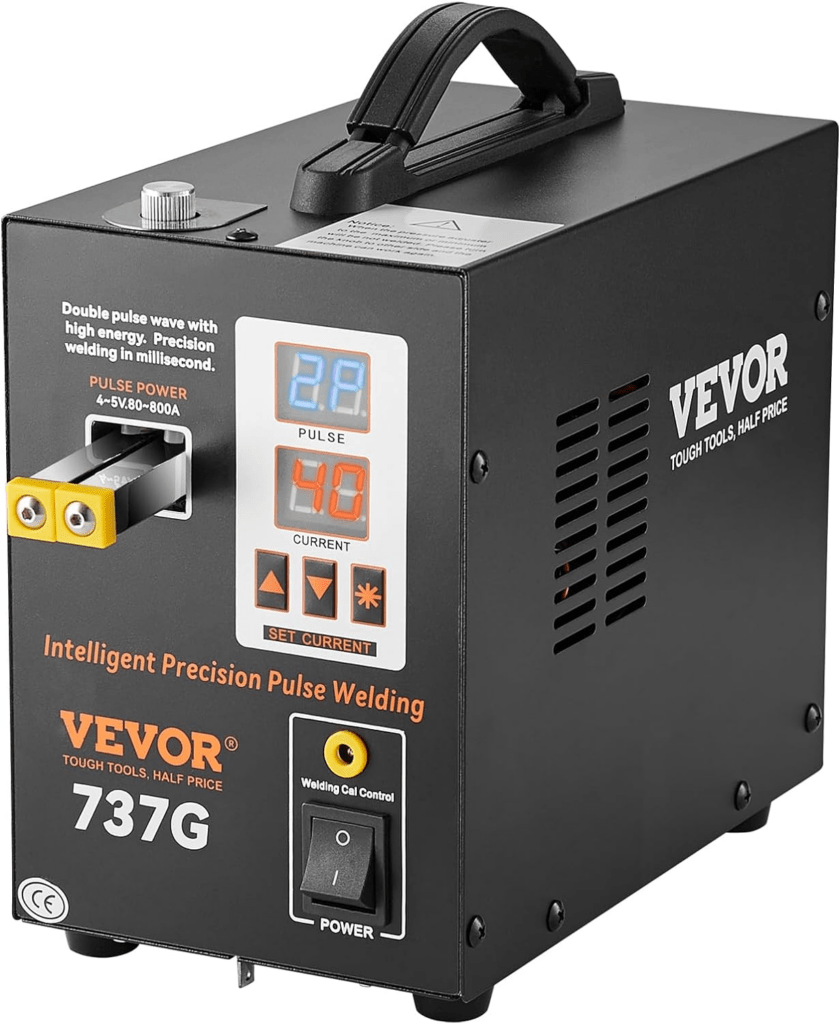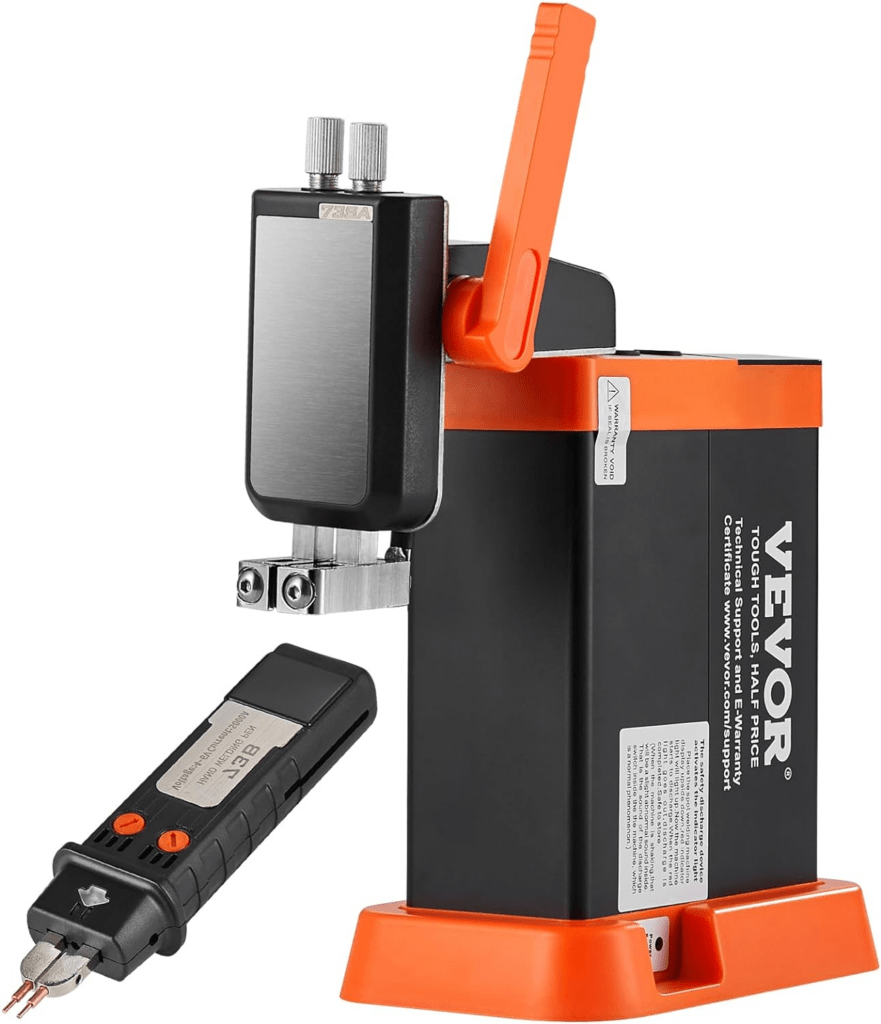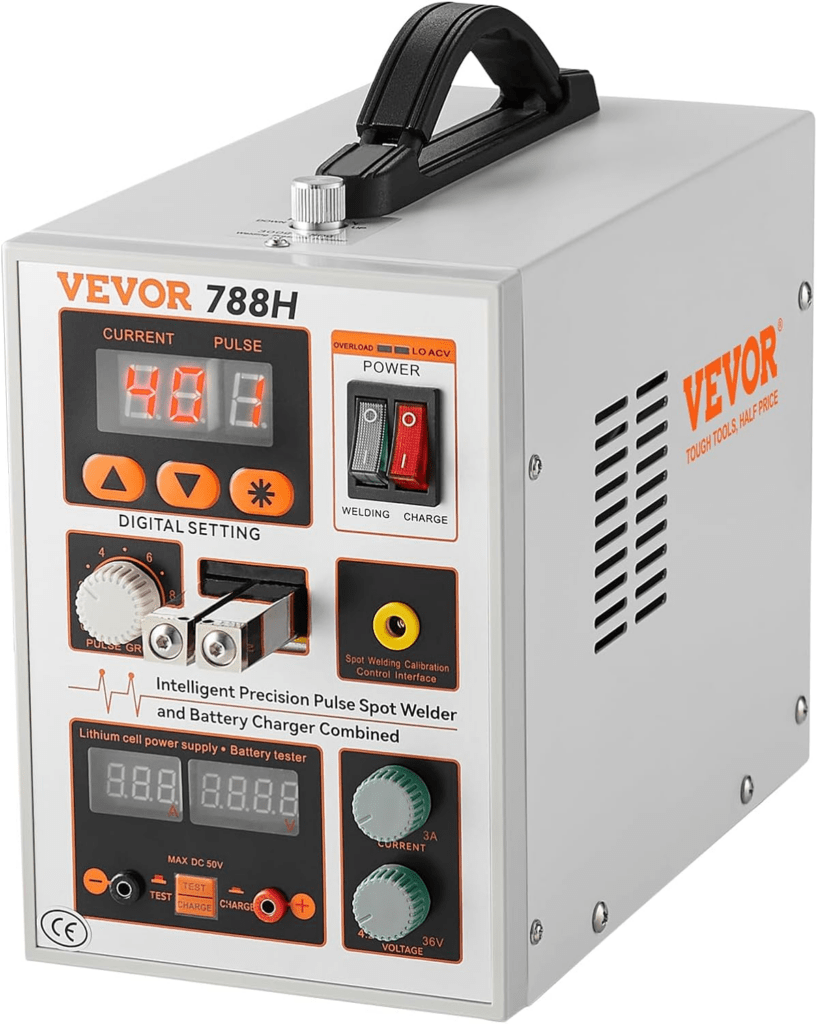A stud welder or stud puller or pulls a nail is a piece of equipment for auto body repair. It is designed to straighten the dents and fix the plate of damaged vehicles. We weld nails or pins on the damaged surface. Then, simply pull it to the outside of the plate to put it in shape.
This tool is essential for repairs accurate without having to remove the body panels.
The term ‘pulling a nail’ in French translates to ‘stud welder’ or ‘stud puller’ in american English.
Presentation of the Stud welder or tire clous
Definition and function
Definition :
A stud welder, or drawing nails is a tool primarily used in body shops for straightening dents and deformations of the sheet metal panels. It works by welding of nails or pins special on the damaged surface of the sheet. Once welded, these nails are used as points of anchorage to apply traction, and straighten sheet metal.

Operation :
Surface preparation : The damaged area of the plate is cleaned to ensure a good grip of the nails.
Welding Nails : The stud welder soda rapidly nails at specific points of the sheet. The welding is carried out by a short passage of electric current through the nail, generating heat sufficient to fuse the metal of the nail with the plate.
Application of Traction :
A tool of power (usually a hammer to inertia or a lifting device) is attached to the studs welded. By pulling on this tool, the technician performs a controlled force to straighten the sheet.
Removing the Nails :
Once the plate adjusted, the nails are removed, and the surface can be sanded and finished to remove any imperfections remaining.
This process allows you to repair the body panels without having to disassemble the parts, thus providing a solution that is fast, accurate and cost-effective for the repair of damaged vehicles.
Importance of the Stud welder in the industry of the body and other sectors.
The stud welder, or pull nails, plays a crucial role in the industry of auto body for a number of key reasons :
Effectiveness and Speed :
The stud welder allows you to straighten the dents and deformations of the sheet metal panels for fast and effective way. Unlike traditional methods, which may require the removal of the body parts, the stud welder allows for repairs on-site, significantly reducing the working time.
Accuracy :
Thanks to the weld accurate nails at specific points, the technicians can apply a traction control exactly where cis necessary. This clarification ensures that the plate is adjusted without creating additional damage, which is essential to maintain the integrity and the appearance of the vehicle.
Quality of Repair :
Repairs carried out with a stud welder are durable and of high quality. The merger of the nails with the plate ensures a solid grip, allowing to recover the damaged areas with a smooth finish. This not only improves the esthetic appearance, but also the residual value of the vehicle.
Cost reduction :
By eliminating the need to disassemble and reassemble parts of the vehicle, the stud welder reduces the labour costs of work and materials. Less disassembly also means less risk of secondary damage and additional costs associated.
Versatility :
The stud welder can be used on various types of sheet metal, that it’s either the traditional steel or from more modern materials such as aluminum. This versatility is essential in order to adapt to different brands and models of vehicles on the market.
Safety :
In for repairs fast and precise, the stud welder helps to improve the safety of vehicles. A body that is properly adjusted maintains the structural integrity of the vehicle, which is essential for the security of the occupants in the event of a collision.
Reduced Environmental Impact :
By avoiding the complete replacement of all sheet metal panels, the stud welder helps to reduce the waste of metal. This makes it an option that is more respectful of the environment compared to the methods of traditional repair.
The stud welder is therefore an indispensable tool for professionals in the automotive body. It combines efficiency, accuracy, and cost reduction, while ensuring high quality repair. It is a technology which fulfills the modern requirements of the automotive industry, providing fast and reliable solutions for the repair of vehicles.
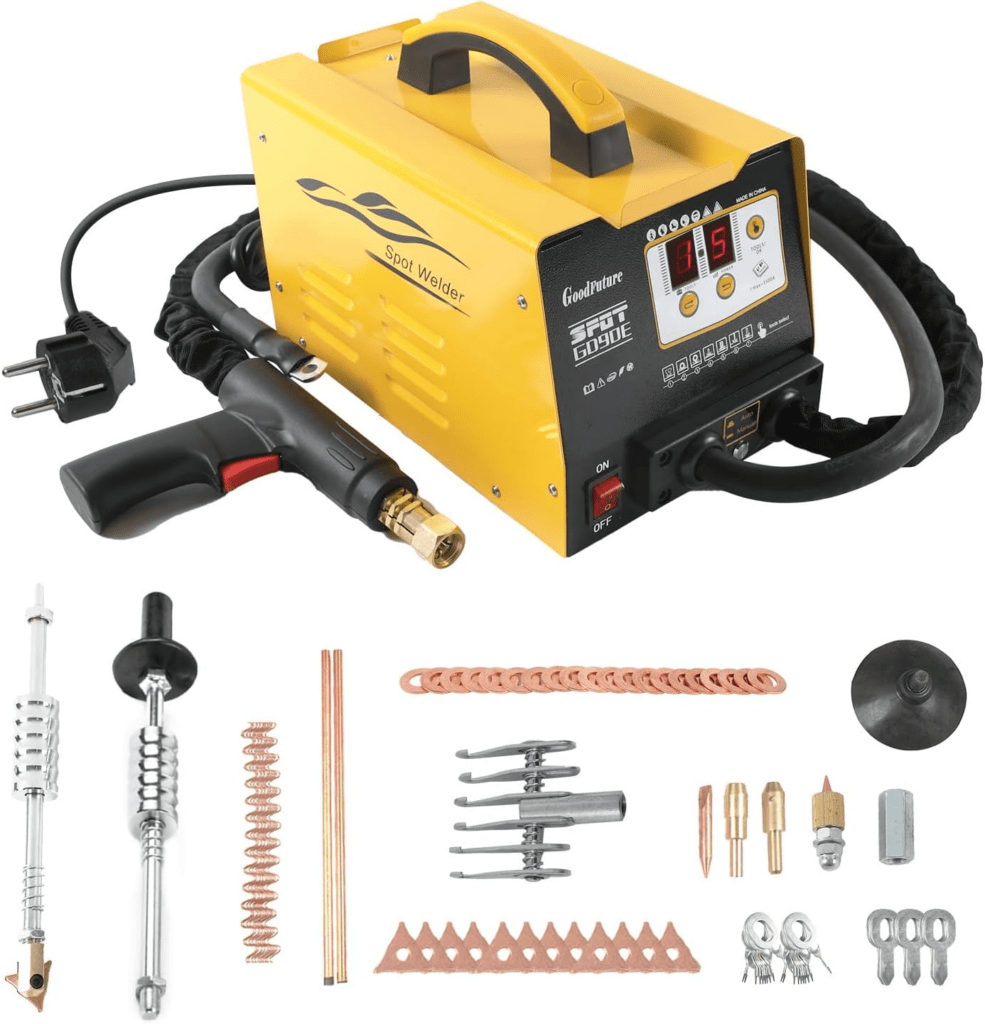
Description of the main components and their role (nails/pins, tool, traction, etc) :
The stud welder, or tire studs is an essential tool in automotive body to straighten the sheet metal panels damaged.
Here’s a detailed description of its main components and their role :
- Welding electrode :
- Role : The electrode is the part of the stud welder that comes in direct contact with the stud or pin that is welded to the sheet metal. It conducts an electric current intense that generates the heat necessary to fuse the nail with the metal surface.
- Description : Usually copper or copper alloy for its high electric conductivity and its heat resistance, the electrode is designed to withstand the conditions of welding repetitive.
- Nails/Pins Soldering :
- Role : nails or pins are the anchor points welded to the steel plate is damaged. They serve as points of traction to straighten the dents and deformations.
- Description : They are made of steel or a material compatible with the sheet metal to repair, available in different sizes and shapes to adapt to various types of damage, and metals.
- Tool (Traction Hammer Inertia, Extractor) :
- Role : This tool is fixed to the studs welded and applies a tensile force to straighten the sheet. The hammer inertia, in particular, is used to pull the sheet toward the outside by repeated blows and controlled.
- Description : The hammer inertia includes a mobile weight on a rod, which slides in and hits a thrust to generate a pulling force. Extractors can also be manual or hydraulic press-ups more controlled.
- Welding gun :
- Role : The gun is home to the electrode and allows the technician to accurately place the nails on the sheet. It is designed to be ergonomic, facilitating prolonged use.
- Description : Lightweight and maneuverable, it is often equipped with intuitive controls to regulate the welding current and the duration of application.
- Control unit :
- Role : This unit regulates the electrical current sent to the electrode, ensuring a weld precise and controlled. It allows you to adjust the welding parameters according to the specific needs of the repair.
- Description : With settings for the power, the welding time and sometimes even the pressure, the control unit is the heart of the operation, ensuring a solder a high quality and consistent.

Key Applications :body
Repair of dents and damage on the car body sheet metal.
Theuse of a stud welder, or drawing nails is essential for various applications in automotive body repair. Here are the main applications :
- Repair of Dents :
- Description : The bumps on the sheet metal panels, often caused by minor collisions or impacts accidental, are common problems in the body.
- Process : stud welder can weld studs on the box dented. A tool of traction, such asa hammer to inertia, is then used to pull nails, and straighten sheet metal. This method is accurate and allows you to restore the metal to its original shape without the need for disassembly of parts.
- Advantage: The repair is quick, avoiding disassembly and reassembly, which reduces the time and cost of main-d’œuvre.
- Repair of Door Panels and Wings :
- Description : The doors and fenders of the car are often damaged by blows of the door, skirmishes and various shocks.
- Process : After you have soldered the nails on the damaged areas, the tool of traction is used to straighten the sheet. This method allows you to reach areas that are difficult of access and recover precisely the sheet.
- Advantage : can be used to repair the damage without having to disassemble the door, or the wings, thus preserving the integrity of the panels.
- Repair of the Covers, and Safes :
- Description : hoods, and chests can be damaged by collisions, front or rear, causing large deformations.
- Process : using nails welded on the deformed areas, technicians can pull the sheet toward theoutside and straighten the parts affected. The stud welder allows a precise application of traction, avoiding of further damage to the surrounding structures.
- Advantage : Allows you to restore the original shape of the doors and chests without having to replace these expensive pieces.
- Repair of the roof of the Car :
- Description : The roof of the car can be damaged by impacts or accidents.
- Process : After you have soldered the nails on the damaged area, an extractor is used to apply a controlled force and straighten sheet metal. This method is particularly useful for large surfaces difficult to reach.
- Advantage : Avoids the expensive replacement of the roof and allows for a quick repair and efficient.
- Strengthening of Structures :
- Description : In addition to redress the bumps, stud welder can be used to strengthen the structures weakened by welding points of anchorage additional.
- Process : The nails are soldered to the critical points to strengthen the structure. These points can then be used to apply traction forces or compression to straighten and stabilize the structure.
- Advantage : Improves the rigidity and durability of structures repaired, ensuring better security and performance of the vehicle.
The stud welder is so essential and versatile to repair bodywork. It allows you to treat a variety of damages with precision, speed and efficiency, reducing costs and repair time while ensuring high quality results.
Typical process of recovery of sheet metal with a Stud welder.
Welding process and traction
- Preparation : The surface is cleaned to ensure a good grip of the nails.
- Welding : The nail is positioned on the plate with the help of the electrode of the welding gun. An electric current intense is applied to weld the stud.
- Traction : The tool of traction is fixed to the stud welded. By pulling on the tool, the metal is recovered to its original form.
- Removal and Finish : The nails are removed once the sheet straightened. The surface is sanded to a smooth finish.
Using these components in a coordinated manner, the stud welder allows for repairs fast, accurate and high-quality, essential for maintaining the integrity and the aesthetics of the vehicle.
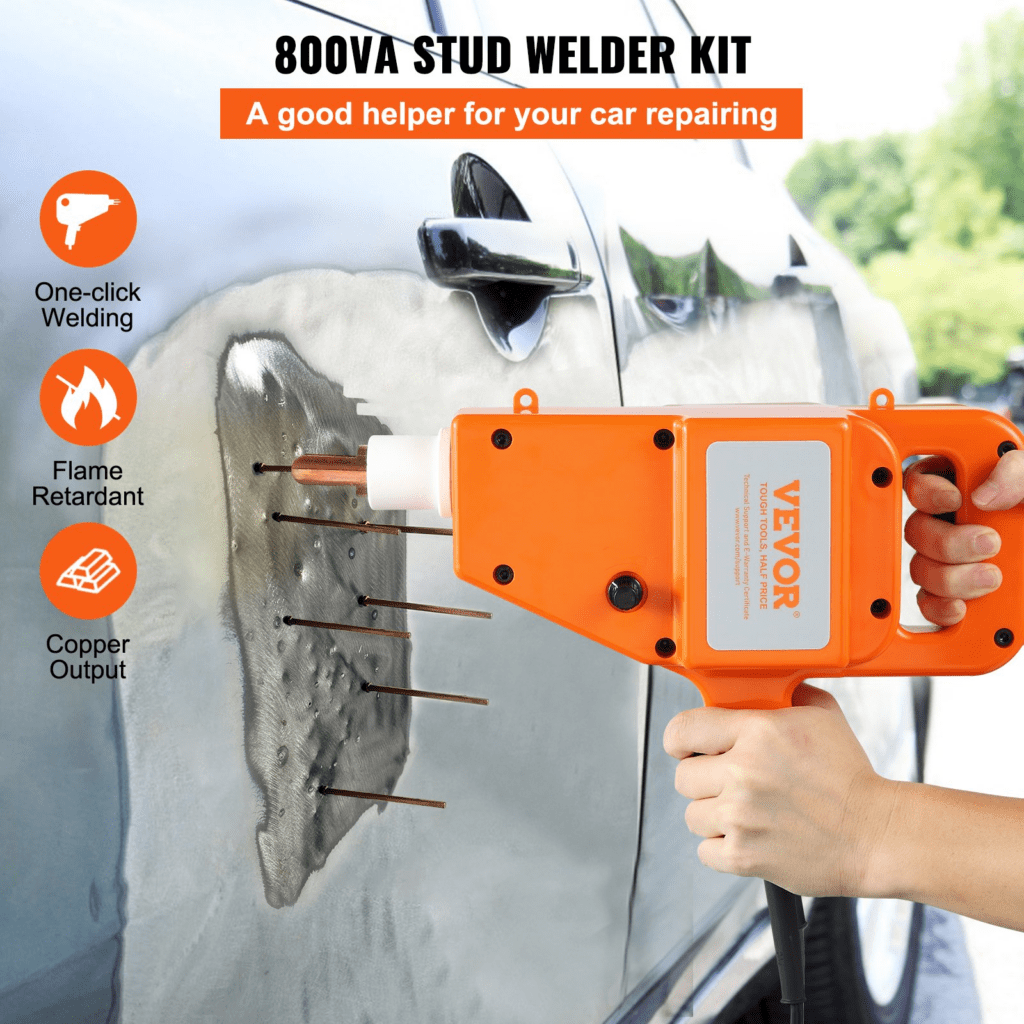
Other possible applications (for example, manufacturing of sheet metal).
In addition to its common use in automotive body, the stud welder offers a versatility that makes it useful in many other industrial fields. Here are some of the possible applications :
- Manufacturing of sheet Metal Industrial :
- Description : The stud welder is used for welding the mounting components on sheet metal parts in various manufacturing sectors.
- Examples : Securing brackets, ducts, and other components on the metal panels used in the construction of machinery, metal structures, and industrial equipment.
- Household Appliance Industry, Bolsters :
- Description : home appliances often composed of metal panels require precise solders to attach components without compromising the integrity of the material.
- Examples : Fixing of hinges, brackets, motors, and structural elements on refrigerators, washing machines, and ovens.
- Aerospace :
- Description : In the aerospace industry, the lightness and strength of materials are crucial. The stud welder is used to fix elements on structures in aluminum and other light alloys.
- Examples : Fixing of panels, coating media of internal equipment, and elements of structural reinforcement on the aircraft.
- Navy :
- Description : marine structures, benefit from the ability of the stud welder to perform welding, solid and durable, essential for corrosive environments.
- Examples : Repair and strengthening of the hulls of boats, fixing of internal components, and installation brackets wiring.
- Farm Equipment :
- Description : agricultural machinery, often subjected to tough working conditions, require welds robust to ensure their longevity and their functioning.
- Examples : Repair of the chassis of a tractor, mounting brackets for equipment and agricultural tools.
- Rail Industry :
- Description : trains and other railway equipment in need of repair and maintenance as well as regular metal structures.
- Examples : Repair of bodies of cars, fixing materials and structure elements on cars and locomotives.

Versatility and Adaptability
The stud welder is extremely versatile and can be adapted to a wide range of materials and of thicknesses. It is capable of welding on various metals such as steel, the aluminum, and even some alloys specific, which makes it useful in a variety of industries :
- Various materials : stainless steel, aluminum, copper, and special alloys.
- Wall thickness : The thin metal used in appliances to thick plates used in ship building and railway.
The stud welder is an indispensable tool not only for the automotive, but also for many other industries that require sturdy joints and repairs to the precise of the metal structures varied.
Benefits of stud welder and quality repairs :
The stud welder, or drawing nails is a tool spot welding is widely used in the automotive industry to repair the dents and deformations of the sheet metal panels. It has many advantages in terms of accuracy and quality of repairs, speed and efficiency, reducing costs of labor and materials, as well as the improvement of safety in the workshop. Here is a detailed overview of these benefits.
Accuracy and quality of repairs
The accuracy is a crucial criterion in any operation for auto body repair. A stud welder excelled in this domain by providing a precise method to straighten the sheet metal panels.
The capacity of the stud welder to weld nails accurately, and to apply a traction control guarantee high quality repair. This precision translates into aesthetic finishes and durable, which is essential to maintain the value of the vehicle repaired.
Welding states :
Description : The stud welder uses an electrode for the welding of nails or pins directly on the damaged surface of the sheet. This weld is localized and precise, allowing technicians to target exactly the areas that require a pull-up.
Advantage : avoiding the heat dissipation and the impact on areas that are not damaged, the stud welder maintains the structural integrity of the sheet metal surrounding.
Traction control :
Description : once the nails welded, a tool of traction as a hammer inertia is used to draw on the nails, and straighten sheet metal. This process allows for a controlled application of force, straightening dents without having to create new strains.
Advantage : The ability to control the force of traction ensures an accurate repair and efficiently, minimizing the risk of over-correction.
High quality finish :
Description : After recovery, the nails are removed and the surface is sanded to a smooth finish. This process ensures that the sheet metal regains its original appearance without imperfections.
Advantage : repairs with a stud welder are sustainable and aesthetically pleasant, contributing to the residual value of the vehicle.
Speed and efficiency
The speed and efficiency are essential criteria in auto body shops, where time is often synonymous with costs.
The speed of the welding process and the simplicity of the recovery of the bumps can reduce the overall time of repair. This efficiency translates to an increase in the yield and the productivity of the workshop, allowing you to handle a larger number of vehicles in less time.
Welding process is fast :
Description : The stud welder performs welding instant in a fraction of a second. This allows you to weld with several nails in a very short time.
Advantage : The speed of welding reduces the overall time of repair, allowing technicians to handle more vehicles in less time.
Recovery efficient :
Description : once the nails welded, the recovery of the bumps is quick thanks to the tool of traction. The selection process is direct and effective, does not require removal of the body parts.
Advantage : The efficiency of the recovery of the bumps contributes to a significant reduction in the time of repair, thus increasing the efficiency of the workshop.
Reduction of the stages of work :
Description : Unlike traditional methods, which may require the removal of the panels for internal access, the stud welder allows for repairs external direct.
Advantage : Less steps of work means less time spent on each vehicle, there by increasing the productivity of the workshop.
Reduction of the labour costs of work and materials
The cost is a major concern in any operation for auto body repair. The stud welder offers significant advantages in terms of cost reduction.
Reducing the time of labor and reducing the need to replace pieces of sheet metal, stud welder offers significant cost savings. Fewer materials and working time result in repair costs low, which is advantageous for customers and workshops.
Less labour-dwork of art :
Description : The speed and effectiveness of the stud welder reduce the number of hours of labor required for each repair.
Advantage : Less time hand-dwork means personnel costs reduced, which is particularly advantageous for the workshops to high volume of work.
Economy of materials :
Description : enabling direct repairs on the sheet metal panels are damaged, the stud welder eliminates the need to replace the whole rooms.
Benefit : The reduction in the need for new parts, reduces hardware costs, which is beneficial to the overall budget of repair.
Less waste :
Description : By repairing rather than replacing, the stud welder helps to reduce the waste of metal.
Advantage : Reduce waste is not only economic but also ecological, which is an additional asset for the workshops conscious of their environmental impact.
Improving safety in theworkshop
Safety is a priority in any working environment, and the use of stud welder helps to create a workshop more secure.
The secure design of stud welders modern and their ability to reduce the risk of burns, electric shock, and inhalation of the fumes create a safer working environment. The reduction of risks associated with the handling of heavy parts also contributes to reducing injuries, improving the overall safety of the technicians.
Reduction of the risk of burns :
Description : The process of spot welding is controlled and fast, minimizing the time of exposure to elevated temperatures.
Advantage : Less exposure time reduces the risk of burns to the technicians.
Reduction in the risk ofelectric shock :
Description : The stud welders are modern and designed with security features to protect against electrical hazards.
Advantage : These safety features ensure the safe use of the equipment, even for the less experienced technicians.
Reduction of theinhalation of the fumes :
Description : The process of spot welding generates less smoke and gas pollutants compared to the welding methods in the traditional way.
Advantage : A working environment with less fumes, improves air quality and reduces the risk to the health of workers.
Safer work environment :
Description : By reducing the need for disassembly and reassembly, the stud welder minimizes the risks associated with the handling and moving of heavy parts.
Advantage : Less parts handling large reduces the risk of physical injury, creating a safer working environment.
The stud welder, therefore, represents a significant advance in the field of automotive body repair. Its advantages in terms of accuracy and quality of repairs, speed and efficiency, reducing costs of laborand materials, and improved safety in the workshop are an essential tool for any body shop, modern.
By integrating the stud welder in the repair, body shops can not only improve the quality and efficiency of their repair, but also create a safer work environment and more economical. It is a wise investment that offers long-term benefits, both for the professional body for their clients.

Choose the right stud welder :
Factors to consider : budget, applications, features, technologies.
At the time of the purchase of a stud welder, it is essential to take into account multiple factors to ensure that the equipment will meet the specific needs of your body shop. Here are the main criteria to consider : the budget, the intended applications and technical specifications.
Budget
- Initial cost :
- The cost of a stud welder can vary greatly depending on the brand, model and features included. Set a realistic budget, taking into account the immediate needs of your workshop and the cost of the initial investment. The high-end models often offer advanced features that can justify a higher cost.
- Long-term cost :
- In addition to the initial cost, consider the maintenance costs, consumables, nails, accessories and training. A model that is more expensive but of higher quality can reduce the cost of maintenance in the long term and offer increased durability, this is a wise investment.
Intended Applications
- Type of repairs :
- Identify the types of repairs that you perform most often, as the recovery of dents, repair door panels, or the strengthening of structures. Choose a stud welder capable of managing these specific applications. For example, if you are working primarily on bumps lightweight, a simpler model may be sufficient. For heavier work, a model that is more versatile and powerful is required.
- Variety of materials :
- The different materials of metal require different settings. Some stud welders are designed for specific metals such as aluminum or stainless steel. Make sure that the stud welder you choose is compatible with the materials that you repair the most often.
- Frequency ofuse :
- The frequency with which you use the stud welder will influence your choice. For intensive use, a model that is sturdy and durable is essential. Opt for a model designed for intensive use, if your workshop deals with a large volume of repairs on a daily basis.
Technical characteristics
- Power and ability :
- The power of the stud welder determines its ability to be welded studs on different thicknesses of metal. Choose a model with a power adapted to your needs. A model with a variable power can offer more flexibility for different types of repairs.
- Controls & adjustments :
- The ability to adjust the power, time and pressure is crucial for repairs accurate. Make sure that the stud welder offers easy settings to use to adjust the welding different situations of repair.
- Ease ofuse :
- A stud welder easy to use, increases the efficiency and reduces the training time needed. Look for models with user interfaces that are intuitive and user-friendly features.
- Portability :
- Portability may be an important factor, especially if you have to move the equipment between different work stations or sites. The portable models offer additional flexibility, while stationary models can offer more power and durability.
- Durability and reliability :
- The sturdy construction and high-quality materials guarantee a long service life of the equipment. Check the reviews and recommendations of users to assess the reliability of the model that you are considering.
- Safety :
- The characteristics of security, such as protection devices against overvoltage and security thermal imaging, are essential to prevent accidents. Make sure that the model you choose is consistent with the safety standards, and includes features robust security.
- Accessories and consumables :
- The available accessories, such as various types of nails and tools traction, may improve the effectiveness and versatility of your stud welder. Opt for a model that is compatible with a wide range of accessories and consumables that are easily available.
The choice of a stud welder suited to your needs depends on a careful evaluation of several key factors : the budget, the intended applications and technical specifications. By taking the time to consider each aspect, you can ensure that the equipment you choose not only meet your current requirements, but also adapt to the future needs of your workshop.
Invest in a stud welder quality can transform the efficiency and accuracy of your repair, while reducing long-term costs and improving the safety of your workshop. Whether you are a body shop high-volume or an experienced independent, choosing the right stud welder is a strategic decision that will impact the overall performance of your business.
Comparison of different types of stud welders available on the market (portable, stationary, etc).
The choice of a stud welder depends on several factors such as the intended application, the frequency of use, budget, and technical requirements. The stud welders are classified mainly into three categories : portable, stationary, and robotic. Here’s an exhaustive comparison of these types of stud welders.
1. Stud welders portable
Description : The stud welders, portable, compact, lightweight and designed to be easily transported. They are ideal for repairs mobile or workshops where space is limited.
Features :
- Portability : Easy to carry, perfect for on-site repair.
- Power : Typically less powerful than stationary models, but sufficient for most repairs of thin-to medium-sized.
- Use : easy to use with a quick learning curve.
- Applications : Repairs dents, fixing of light weight panels, use in tight spaces.
Benefits :
- Mobility : Ideal for technicians who are working on different sites.
- Cost : Often less expensive than stationary models and robotic.
- Installation : Requires minimal setup and configuration.
Disadvantages :
- Power Limited : Less adapted to work a heavy or thick materials.
- Durability : Less robust for intensive use in relation to models of stationary.
Examples of Models :
- H&S Autoshot 4550 Starter Plus Stud Welder
- Dent Fix DF-505 Maxi
2. Stud welders stationary
Description : The stud welders, stationary fixed machines installed in a workshop. They offer more power and advanced features, suitable for heavy work and heavy usage.
Features :
- Power : Higher, capable of processing thicker materials.
- Stability : Mounted in a fixed manner, which allows for the use of more stable and continuous.
- Use : advanced user Interface with precise adjustments for different types of materials, and nails.
- Applications : emergency Repairs, series production, structural reinforcement, fixing components are heavy.
Benefits :
- Performance : More powerful and suitable for a wide range of tasks.
- Durability : Designed for intensive use and long lasting.
- Features : advanced Options such as digital control, memory settings, etc
Disadvantages :
- Mobility : Non-transportable, limited to a fixed location.
- Cost : More expensive than portable models.
Examples of Models :
- Tite-Spot 230V Stud Welder
- Car-O-Liner CTR12000 Fully Automatic Spot Welder
3. Stud welders robotic
Description : The stud welders robot are integrated in automated systems for industrial applications on a large scale. They are often used in the production chains automated.
Features :
- Automation : Controlled by robots, which allows operations without human intervention.
- Accuracy : Extremely accurate with automatic settings for a wide variety of tasks.
- Use : advanced Programming for cycles of welding repeated and consistent.
- Applications : series Production, industries requiring high precision and high efficiency, such as automotive and aerospace.
Benefits :
- Efficiency : High-efficiency and productivity through automation.
- Quality : Welds of consistent and high quality with consistent accuracy.
- Safety : Less risk for the operators thanks to the full automation.
Disadvantages :
- Cost : Very expensive initial investment and high maintenance costs.
- Complexity : Installation and programming complex, require specialized training.
Examples of Models :
- Fanuc R-2000iC/165F Robot with Welding Package
- KUKA KR 16 Arc HW Robot
Comparison of key factors
| Critère | Portables | Stationnaires | Robotisés |
|---|---|---|---|
| Portability | Very high, easy to carry | Low, fixed in a place | Null, integrated systems stationary |
| Power | Moderate, suitable for light-weight materials to medium | High, suitable to a wide range of materials and tasks | Very high, suitable for heavy duty industrial applications |
| Ease of use | Easy, quick learning | Average, requires an initial training | Complex, requires programming and advanced training |
| Applications | Repairs lightweight, mobile use | Repair lourdes, series production, heavy use | Series Production, industrial applications of automated |
| Cost | Low to moderate | Moderate to high | Very high |
| Sustainability | Modérée | High, designed for intensive use | Very high, designed for continuous production |
| Advanced features | Limitées | Advanced, with options for digital control | Very advanced, full integration with production systems, automated |
The choice of a stud welder will mainly depend on your specific needs, your budget, and the work environment. For repairs of mobile and workshops with limited space, a stud welder is portable and ideal. If you need more power and durability for intensive work, a steady-state pattern is more appropriate. Finally, for industrial applications, large-scale, requiring batch production, stud welders robotic offer an optimal solution in spite of their high cost and complexity.
In assessing carefully these criteria, and understanding the advantages and disadvantages of each type of stud welder, you will be able to make an informed choice that will maximize the efficiency and profitability of your workshop.
Brands and models recommended.
Here is a list of brands and models recommended for each type of stud welder : portable, stationary, and robotic. These recommendations are based on their reputation, their performance, and user reviews.
Portables
- H&S Autoshot
- Model : 4550 Starter Plus Stud Welder
- Features : Compact, lightweight, easy to use. Ideal for repairs, mobile, and small to medium-sized repairs of dents.
- Tooth Fix
- Model : DF-505 Maxi
- Features : Powerful, portable, and equipped with variety of accessories for a wide variety ofapplications of body.
- Motor Guard
- Model : JO1050
- Features : welding System, simple and efficient, ideal for bodywork repairs quick and mobile.
- Uni-Spotter
- Model : 9000 Deluxe
- Features : Portable, economic, and comes with a complete kit for repair dents.
Stationnaires
- Car-O-Liner
- Model : CTR12000
- Features : Fully automatic spot welder, suitable for intensive use with advanced features digital control.
- Pro Spot
- Model : SP-2
- Features : High-performance, used for bodywork repairs heavy. Provides high accuracy and automatic settings.
- Tite-Spot
- Model : 230V Stud Welder
- Features : Powerful and robust, designed for the repair of body stationary with a large capacity of welding.
- Tecna
- Model : 3664P
- Features : Spot welder stationary with options for fine-tuning and high durability for the workshops at high volume.
Robotisés
- Fanuc
- Model : R-2000iC/165F with Package Soldering
- Features : robotic System advanced for heavy duty industrial applications. Offers high precision and full automation.
- KUKA
- Model : KR 16 Arc HW Robot
- Features : Designed for welding applications in the series, with a high accuracy and advanced programming features.
- ABB
- Model : IRB 6700
- Features : Robot versatile and robust, used in various welding applications automated with high efficiency.
- Yaskawa
- Model : Motoman MA1440
- Features : Robot welding with a large scope and a high load capacity, ideal for automated production lines.
The choice of a stud welder depends on your specific needs in terms of mobility, power, durability, and automation. The portable models such as the H&S Autoshot 4550 and the Dent Fix DF-505 are perfect for the repairs mobile and small workshops. For more intensive and stationary, and stationary models as the Car-O-Liner CTR12000 and the Pro Spot SP-2 provide power and with greater accuracy. Finally, for large production lines in industrial, robotic systems, such as the Fanuc R-2000iC/165F and the KUKA KR 16 Arc HW Robot provide automation and efficiency that is unparalleled.
By selecting the one of these templates according to your specific requirements, you can optimize your operations, welding studs and improve the quality of your bodywork repairs.
Selection criteria based on the reputation and performance.
When the choice of a stud welder, it is essential to take into account several criteria related to the reputation and performance of the equipment and of the brand. Here are the main criteria to consider :
1. Reputation of the brand
- Durability and reliability :
- Description : A well-known brand for the durability and reliability of its products, is generally a good indicator of quality. Products that last a long time and require little maintenance to reduce costs in the long term.
- Examples : Car-O-Liner, Pro Spot, and a Tooth Fix are often praised for their durability and reliability.
- After-sales Service and technical Support :
- Description : The availability ofa good after-sale service and of an efficient technical support is crucial. A good technical assistance to guarantee a quick resolution of problems and minimizes the time ofjudgment.
- Examples : brands such as Fanuc, and KUKA offer technical support that is known and availability of spare parts.
- User reviews :
- Description : The reviews and testimonials from users provide valuable information about the actual performance and the satisfaction of the customers. Looking for advice on professional forums and sites of evaluation.
- Examples : The models such as the Dent Fix DF-505 Max and the Car-O-Liner CTR12000 have numerous positive reviews from professionals of the body.
2. Performance of theequipment
- Power and ability :
- Description : The power of the stud welder must match the types of repairs and materials that you deal with frequently. A equipment that is more powerful and is able to weld thicker materials and more resistant.
- Examples : The Pro Spot SP-2 is known for its ability to handle heavy materials with a high degree of accuracy.
- Precision and control :
- Description : The ability to adjust the power, duration, and pressure welding is crucial for high-quality results. Models with digital controls generally provide better accuracy.
- Examples : The Car-O-Liner CTR12000 provides automatic adjustments for increased accuracy.
- Ease of use :
- Description : A stud welder easy to use, increases the efficiency and reduces the training time needed. Look for models with user interfaces that are intuitive and easy setting.
- Examples : The H&S Autoshot 4550 is appreciated for its simplicity of use, even for beginners.
- Versatility :
- Description : The ability of the equipment to adapt to various types of work (repairs of dents, fixing of panels, structural strengthening) is a major asset. Most equipment is versatile, it can be useful in a body shop.
- Examples : The Dent Fix DF-505 Max is known for his versatility in different applications of body.
- Safety :
- Description : safety features, such as protections against voltage surges and cooling systems, are essential to prevent accidents and to prolong the life of the equipment.
- Examples : The models of the KUKA and Fanuc incorporate advanced security features for industrial environments.
- Quality-price ratio :
- Description : A good quality-price ratio implies that the cost of the equipment is justified by its performance and its features. It is not simply a matter of choosing the least expensive option, but one that offers the best return on investment.
- Examples : The Motor Guard JO1050 offers an excellent price-quality ratio for small repair shops.
To choose a stud welder based on the reputation and performance, it is therefore crucial to carefully evaluate the criteria of reliability, durability, technical support, and user reviews. In parallel, the performance of the equipment should be examined in terms of power, accuracy, ease of use, versatility, safety, and quality-price ratio.
Taking into account these criteria, you can select a stud welder that not only meets your current needs, but also adapted to the future requirements of your body shop, ensuring high quality repair and optimal operational efficiency.
Tips to use a stud welder
Good practices for safe and efficient utilization of a stud welder.
The use of effective and safe management of a stud welder is essential to ensure high quality repair while minimizing the risk to the operator. Here are some best practices to follow :
1. Preparation and safety
- Personal protective equipment (PPE) :
- Safety goggles : To protect the eyes from sparks and debris.
- Heat resistant gloves : To protect hands from burns.
- Protective clothing : Wear fire retardant clothing to prevent burns.
- Preparation of the work area :
- Clean and tidy area : Make sure that the work area is clean and free of flammable materials.
- Ventilation : good ventilation is necessary to prevent the accumulation of fumes and gases that are potentially harmful.
- Inspectionequipment :
- Checking connections : Make sure all electrical connections are tight and in good condition.
- All cables : Inspect the cables to detect any wear or damage.
- Tool for traction and electrodes : make sure that the electrodes and the tool of traction are clean and in good working condition.
2. Settings and adjustments
- Selection of the correct power :
- Material Type : Adjust the power as a function of the thickness and type of material to be welded. A power too high can burn the metal, where as an insufficient power can lead to weld low.
- Preliminary tests : Perform tests on pieces of scrap to properly adjust the power before working on the final piece.
- Setting the weld time :
- Welding time optimal : Adjust the duration of the welding to ensure a merger adequate without overheating the metal.
- Pressure welding :
- Uniform pressure : Apply an even pressure to avoid welds on uneven or weak.
3. Welding technology
- Precise positioning :
- Investment nails : Put the nails, or pins exactly where repair is required to avoid weld unnecessary.
- Use of templates : Use templates or marks for precise placement and uniform of the nails.
- Stable maintenance :
- Stability of thetool : Press and hold the welding tool stable and perpendicular to the surface to ensure a uniform welding.
- Visual inspection :
- Weld Inspection : Visually inspect each weld to ensure that it is solid and well made. Redo all welds that seem weak or faulty.
4. After welding
- Cleaning :
- Surface cleaning : Remove excess solder and clean the surface to verify the integrity of the weld.
- Maintenance of thetool : Clean the welding tool and the electrodes to prevent the accumulation of residue, and extend the life of the equipment.
- Security check :
- Turn off theequipment : Make sure that the equipment is switched off and unplugged after use.
- Secure storage : Store the stud welder in a safe, dry place to avoid damage or accident.
- Documentation and follow-up :
- Service log : Keep a log of maintenance to keep the checks and routine maintenance.
- Recording settings : Note the settings used for different tasks for future reference.
By following these best practices, you can maximize the effectiveness and safety of the use of your stud welder. Careful planning, precise adjustments, a technique of welding proper and regular maintenance will guarantee high-quality results and prolong the life of your equipment.
The safety should always be a priority, using the proper personal protective equipment and work area, secure and well ventilated.
Avoid the common mistakes.
The use of a stud welder may seem simple, but there are several common errors that the users can commit, thus reducing the efficiency of the process and jeopardizing the security. Here are the mistakes to avoid to ensure repairs of high-quality and safe use :
1. Poor preparation of the surface
- Surface dirty or improperly cleaned :
- Error : failure to properly clean the surface prior to welding can lead to poor adhesion of the nail or pin.
- Solution : Always clean the surface of any dirt, paint, rust or oil before you start soldering.
- Preparation incomplete :
- Error : Do not completely remove the paint or protective coatings.
- Solution : Use of abrasive tools to ensure that the bare metal is exposed prior to welding.
2. Incorrect settings
- Power is not properly adjusted :
- Error : Use a power too high can burn the metal, where as a power that is too low can result in a weld low.
- Solution : Adjust the power according to the thickness and type of material. Perform tests on pieces of scrap to find the right settings.
- Duration of welding inappropriate :
- Error : A weld time too long may overheat the metal, where as a too short duration does not allow membership to be correct.
- Solution : Set the duration of welding according to specifications of the material and pre-testing.
3. Technical welding inappropriate
- Incorrect position :
- Error : Place the nail or pin in the wrong place can lead to inefficient repair.
- Solution : The use of trademarks or templates for precise placement. Sensure that the nail is placed exactly where repair is necessary.
- Lack of stability :
- Error : Do not keep the tool stable can lead to weld unequal.
- Solution : Maintain the tool firmly and stably during the welding process.
4. Lack of verification and monitoring
- Lack of enforcement :
- Error : Do not inspect each weld can lead to faulty welding is not detected.
- Solution : Always visually inspect each weld, and test its strength.
- Forgotten maintenance :
- Error : Neglecting the regular maintenance of the equipment can lead to system failures and inefficiencies.
- Solution : Perform checks and regular maintenance of the tool, including the cleaning of the electrodes and checking the cables.
5. Security issues
- Not wearing the personal protective equipment (PPE) :
- Error : Do not wear safety glasses, heat resistant gloves, or appropriate clothing.
- Solution : Always wear the PPE recommended to protect against burns, sparks and debris.
- Work area poorly ventilated :
- Error : Work in an area poorly ventilated can cause inhalation of harmful fumes.
- Solution : Sensure that the work area is well ventilated, use systems forsmoke extraction, if necessary.
- Incorrect handling of the equipment :
- Error : Leave the equipment switched on without supervision or manipulate the cables incorrectly.
- Solution : Always turn off and unplug the equipment when it is not used, and handle the cables with care to avoid damage.
To avoid all of these common errors in the use of a stud welder is crucial to ensure repairs of high quality and to ensure the safety of the operator.
By preparing properly the surface, by adjusting the settings with precision, using an appropriate technique, verifying and regularly welds, and respecting the security protocols, you can maximize the effectiveness of your stud welder and extend its life. These good practices will also help to minimize the risk of injury and of accidents in the workshop.
Maintenance and servicing
Recommended procedures to ensure longevity and optimal performance of the tool.
To ensure the longevity and optimal performance of a stud welder, it is crucial to follow maintenance procedures and of maintenance on a regular basis. Here are the main recommendations :
1. Preventive Maintenance
- Regular Inspection :
- Frequency : Inspect the tool before and after each use.
- Checks : Look for signs of damage to the cables, the electrical connections to the electrodes and the components of the tool and pull. Replace damaged parts immediately.
- Cleaning the equipment :
- After each use : Clean the electrodes and the contact surfaces to prevent the accumulation of residues of welding that can affect the quality of the welds.
- Equipment used : Use a wire brush or a lint-free cloth to clean the electrodes and the surfaces.
- Check electrical connections :
- Frequency : Weekly.
- Checks : Make sure all electrical connections are tight and in good condition. Loose connections can cause electrical arcs or interruptions of welding.
2. Maintenance components
- Cables and connectors :
- Frequency : Monthly.
- Maintenance : Inspect the cables for signs of wear or deterioration. Replace any damaged cables to avoid short-circuits and interruptions of service.
- Electrodes :
- Frequency : After each use.
- Maintenance : The electrodes are worn or contaminated must be cleaned or replaced. Make sure that they are well adjusted and that they make good contact with the work surface.
- Tool tension :
- Frequency : Monthly.
- Maintenance : Check the state of the tool and pull lubricate the moving parts to ensure smooth operation. Replace worn or damaged parts.
3. Appropriate storage
- Storage environment :
- Conditions : Store the stud welder in a dry, clean place, to the shelter of the humidity and temperature extremes. The moisture can cause corrosion of the electrical and mechanical components.
- Security : Make sure that the equipment is unplugged and stored in a manner to avoid falling or accidental damage.
- Protection against dust :
- Action : Use protective covers to prevent dust and debris from sto accumulate on the equipment.
4. Correct use of theequipment
- Respect of the capacity of the tool :
- Practical : Use the stud welder in accordance with the manufacturer’s specifications. Do not exceed the limits of power and duration are recommended to avoid overheating and damage to the equipment.
- Training and competence of the operator :
- Training : Make sure all operators are given adequate training in the safe use and efficient of the stud welder.
- Practices : Encourage the operators to follow best practices and to report immediately any problem or malfunction.
5. Documentation and follow-up
- Service log :
- Documentation : Keep a log of maintenance, detailing all inspections, cleaning, repairs and replacement of parts.
- Benefits : A history of maintenance helps to identify trends and plan preventative maintenance, reducing the time to stop unexpected.
- Planning of maintenance :
- Calendar : Make a schedule of regular maintenance depending on the use of the equipment and the manufacturer’s recommendations.
To ensure the longevity and optimal performance of a stud welder requires a constant attention to the preventive maintenance, the regular cleaning, checking components, and the appropriate storage of the equipment.
By following these recommended procedures, you can minimize the risk of breakdowns, extend the life of your equipment, and maintain welding performance, high quality. A rigorous documentation and follow-up interviews will also contribute to the effective management of the equipment in your auto-body shop.
Security issues
Potential risks associated with the use of a stud welder (burns, electric shock, inhalation of the fumes).
Theuse of a stud welder has several potential risks, including burns, the shock, and the inhalation of the fumes. It is essential to be aware of these dangers to be able to prevent and ensure safe use of the equipment.
1. Burns
Risks :
- Intense heat : The stud welders generate an intense heat needed for soldering the nails on the metal surfaces. This heat can cause severe burns if skin comes into contact with the hot parts of the equipment or the metal surface of the freshly welded.
- Sparks and debris : The sparks and particles of hot metal can cause burns on exposed skin.
Prevention :
- Personal protective equipment (PPE) : Wear heat-resistant gloves, protective clothing, non-flammable, and safety glasses to protect the eyes and skin.
- Management of the work area : Ensure that the areas close to the equipment are clear of flammable materials, and that operators are aware of hot surfaces.
2. Electric shock
Risks :
- Electrical Contact : The stud welder works at the electricity, and poor maintenance or improper handling may result in electric shock.
- Connections defective : electrical connections loose or damaged, increase the risk of electric shock.
Prevention :
- Regular Inspection : Periodically check the condition of the cables, connections and other electrical components to ensure that they are in good condition.
- Correct use : Follow the manufacturer’s instructions for the use and maintenance of the equipment. Avoid using the stud welder in damp or wet.
- EPI electric : Wear insulating gloves and shoes with insulating soles to reduce the risk of electric shock.
3. Inhalation of the fumes
Risks :
- Toxic fumes : The process of welding may produce fumes and gases are potentially toxic, including metal oxides, and chemical compounds.
- Long-term effects : The regular inhalation of these fumes can cause respiratory problems and other health problems in the long term.
Prevention :
- Ventilation : Ensure adequate ventilation in the work area to disperse the fumes. Use systems for smoke extraction, if necessary.
- Respirators : Wear a niosh respirator designed to filter the smoke and other harmful particles.
- Open spaces : Work spaces well-ventilated areas oroutdoors where it is possible.
4. Other risks
Risks :
- Damage to the eyes : The sparks and the intense light of the welding can cause damage to the eyes.
- Fire : sparks can ignite flammable materials near the work area.
Prevention :
- Safety glasses : Always wear safety goggles to protect the eyes from sparks and the intense light.
- Materials management inflammables : Keep the work area free of flammable materials, and have fire extinguishers on hand.
- Delimitation of the area : Delimit the area of welding and inform persons in the vicinity of the potential dangers.
Know and understand the potential risks associated with the use of a Stud welder is crucial to prevent accidents and injuries. By taking preventive measures, such as the wearing of appropriate PPE, the regular maintenance of the equipment, efficient management of ventilation and the proper training of operators, you can significantly reduce these risks. The safety should always be a priority in the use of any welding equipment to ensure a safe working environment and productive.
Safety measures to be followed to avoid accidents.
To ensure secure use of a stud welder and prevent accidents, it is essential to follow stringent security measures. Here are the main recommendations to follow :
1. Use of personal protective equipment (PPE)
- Heat resistant gloves :
- Protect your hands from burns caused by the intense heat and sparks.
- Safety glasses or solder mask :
- To prevent eye damage from sparks and the intense light of the welding.
- Protective clothing :
- Wear non-flammable, that cover the arms and legs to avoid burns.
- Safety shoes with insulating soles :
- Reduce the risk of electrical shock wearing the right shoes.
- Respirator mask :
- Use a respiratory mask to protect your lungs from smoke and toxic gases.
2. Preparation and organization of the work area
- Ventilation :
- Ensure good ventilation of the work area to remove fumes and gases hazardous to health. Use of smoke extractors if necessary.
- Delimitation of the welding zone :
- Enclose the welding area and make sure that only authorized people have access to it.
- Distance to flammable materials :
- Keep flammable materials at the gap in the welding area to prevent fires.
3. Inspection and maintenance of the equipment
- Inspection before use :
- Check the condition of cables, electrodes and electrical connections prior to each use for signs of damage.
- Regular maintenance :
- Perform regular maintenance of the equipment, including cleaning of the electrodes and the verification of the electrical components.
- Replacement of worn parts :
- Immediately replace worn or damaged parts to avoid malfunctions and accidents.
4. Correct use of theequipment
- Appropriate settings :
- Adjust the power and duration of welding according to specifications of the material to prevent overheating and the welds of poor quality.
- Manual ofuse :
- Always read and follow the instructions in the manual of use of the manufacturer.
- Training of operators :
- Make sure that all operators have received adequate training in the safe use and effectiveness of the stud welder.
5. Measures electrical safety
- Avoid humidity :
- Never operate the stud welder in damp or wet to reduce the risk of electric shock.
- Disconnection of the power supply :
- Disconnect the equipment from the power supply when it is not in use and before any maintenance operation.
- Use of jacks and cables properly insulated :
- Make sure that the plugs and cables are properly insulated and in good condition.
6. Procedures of emergency
- Fire extinguishers nearby :
- Have appropriate fire extinguishers on hand to quickly turn off all the beginning of thefire.
- First-aid training :
- Train operators to provide first aid to be able to react quickly in the event ofan accident.
- Plan of evacuation :
- Implement and communicate a plan of escape in case of emergency.
By following these safety measures, you can minimize the risk of accidents and ensure a safe and effective your stud welder. The safety should always be a top priority in the workshop to protect not only the equipment, but also the health and safety of operators. Constant vigilance, proper training, and attention to detail are essential to maintaining a work environment that is safe and productive.
Glossary of terms
- Welding : A welding process used to join two pieces of metal by heating them to a specific point, and then applying a pressure to join them.
- Spot welder (or welding by points) : A piece of equipment used to perform the welding points, consisting of a pair of electrodes between which an electric current is applied to generate heat.
- Stud welding (or electrode) : A small metal rod used during the welding points to transfer the electrical current and generate heat at the point of contact with the parts to be welded.
- Welding gun : The set of electrodes and the clamping mechanism that holds the pieces to be welded in place during the process of welding points.
- Weld bead : The area of molten metal formed at the welding points, which merges the parts to be welded together.
- Tire-nail : A tool used to remove the nails of the weld after the welding process by points, to complete the repair of the body.
- Reinforcement of structure : metal parts added to a car body in order to strengthen its structure and improve its resistance to impacts.
- Sheet ofsteel : A sheet material of steel used for the manufacture of automobile bodies and of other metal parts.
- Thickness of the material : the measurement of the thickness of a piece of metal, which can influence the parameters of welding points such as the potency and duration.
- Repair of dents : The process of correction of minor damage on the surface of a car body by using a stud welder to pull out and straighten the dents.
- Corrosion-resistant coating : A layer of protection is applied on metal surfaces to prevent corrosion and prolong the life of the body.
- Assembly of parts : The act of attaching metal parts together to form a larger structure, often done with the help of the welding points.

